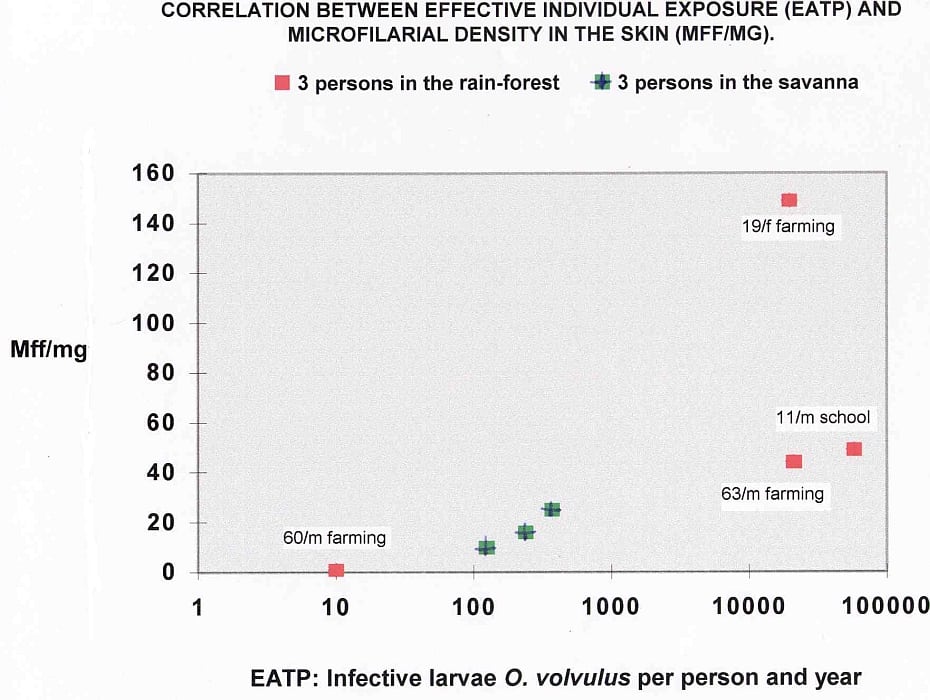The epidemiology of human onchocerciasis in Cameroon
Starting in 1976 and in collaboration with Drs John Anderson and Harald Fuglsang, we studied the prevalence of human onchocerciasis in various regions of Cameroon and collected entomological, parasitological and ophthalmological date to follow-up the longitudinal evolution of the endemic disease:
Starting in 1976 and in collaboration with Drs John Anderson and Harald Fuglsang, we studied the prevalence of human onchocerciasis in various regions of Cameroon and collected entomological, parasitological and ophthalmological date to follow-up the longitudinal evolution of the endemic disease:

Endemicity of human onchocerciasis in Cameroon (A. Renz)
There is a clear correlation between intensity of transmission (ATP, Annual Transmission Potential; infective larvae per man and year) and the mean microfilarial density in the village population:

It is the daily behaviour of man and bloodseeking Simulium flies, that bring both hosts together and thus enables the transmission of Onchocerca volvulus. In order to quantify the dynamics of onchocerciasis transmission, we measured both the exposure behaviour of man (DVF, Daily Visiting Frequency = Number of man-hours per day at a given place) and blood-hungry Simulium flies (DBR, Daily-or Annual- Biting Rate on a fully exposed person):

Simulium Biting Densities, Onchocerca transmission Potentials and Human Daily Visiting Frequencies around the village Rey Manga in North Cameroon (from Renz et al. 1987)
From these data, a critical level for a tolerable Annual Transmission Potential was developed, i.e. an entomological criterium for a level of endemicity of onchocerciasis, which might still be considered tolerable, as there are but few eye-lesions. This criterion was set to 100 L3 of O. volvulus per man and year and 1,000 flies/man, year (Renz, WHO-SAP meeting in 1977, Renz et al. 1987). It was adapted by the Onchocerciasis Control Programme (OCP-WHO) in West-Africa as the criterion for successful control of transmission by treating the Simulium breeding rives with insecticides. It is still valid today.
The threshold level for elimination of the parasite is much lower, however, and is probably as low as an ATP of 10 L3/man,year. Such a very low transmission is almost impossible to measure in the field, as it would mean, that only 10 L3s would be expected to be found, if a fly-collector was working every day from dawn to dusk throughout every day of the year, and all attacking flies were dissected for O. volvulus L3s. Still the ATP measured at the river bank, where transmission is highest, might not be representative for the average person in the village, who usually is much less exposed. We therefore developed methods to estimate the Effective Annual Transmission Potential (EATP, Renz et al. 1987, Jacobi et al. 2010) to which subgroups of the village population are exposed.

Correlation between the Effective Annual Transmission Potentials and the microfilarial density in such exposed persons (from Jacobi et al., 2010)
Boys are much more exposed than girls, and this explains to a large extend the much higher prevalence of parasites and blindness in males.

Differential exposure of boys and girls, men and women with respect to their clothing, which protects from Simulium bites (Orig. A. Renz)
Onchocerciasis, like most of the cyclically transmitted diseases, has a very high Basic Reproductive Number Ro. That is the number of new ‘infections’ that a single human onchocerciasis patient can generate during the lifetime of his ‘infection’, when all flies coming to bite on him (under natural condition) would the transmit the infective L3 into a perfectly naive population.
However, density-dependent regulatory mechanisms quickly reduce this Basis Number to the Effective Reproductive Rate Reff, which must equal 1 in an endemic situation, where there is no growth in the human host population: Then, every single adult worm (female) can only generate one single offspring female:

Ro and Reff: Density-dependent self-limitation of worm population (A. Renz)
This is why eradication is extremely difficult, when Ro is higher than 10:

Eradication is difficult in view of the high Ro and the longevity of worms (Orig. A. Renz)

